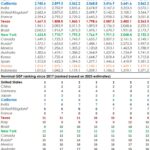When analyzing stock charts, the type of price scale used significantly impacts interpretation. The two most common types are linear and logarithmic (log) scales, and understanding their differences is crucial for effective analysis. This article explores the key distinctions between these two scales and how they affect the visualization of price movements.
Linear vs. Logarithmic Scales: A Detailed Comparison
Both linear and logarithmic scales visually represent price changes over time, but they do so in fundamentally different ways. This difference stems from how each scale represents price increments on the vertical (Y) axis.
Linear Scale: Equal Price Increments
A linear scale uses equal spacing between price points. For instance, the distance between $10 and $20 is the same as the distance between $50 and $60. This represents absolute price changes, making it easy to see the dollar amount of price fluctuations. However, this scale can be misleading when comparing percentage changes, especially over long periods. A $10 increase on a $20 stock is a 50% gain, while a $10 increase on a $100 stock is only a 10% gain. A linear scale won’t visually differentiate the significance of these percentage changes.
Fig 1. Example of a linear scale chart. Note the equal spacing between price levels.
Logarithmic Scale: Equal Percentage Increments
A logarithmic scale, on the other hand, displays price movements based on percentage changes. Equal vertical distances represent equal percentage changes, not equal price changes. For example, the distance between $10 and $20 (a 100% increase) will be the same as the distance between $20 and $40 (also a 100% increase). This allows for a better visualization of proportional price changes, highlighting significant growth or decline regardless of the absolute price level. This is particularly useful for long-term analysis where compounding returns play a significant role. A log scale accurately reflects the impact of a 50% gain on a $20 stock compared to a 10% gain on a $100 stock.
Fig 2. Example of a logarithmic scale chart. Note how equal percentage changes are reflected by equal vertical distances.
Which Scale Should You Use?
The choice between linear and logarithmic scales depends on the specific analytical needs.
- Short-Term Analysis: Linear scales might be preferable for short-term trading where focusing on absolute price changes and identifying specific price targets are crucial.
- Long-Term Analysis: Logarithmic scales are generally recommended for long-term investors as they better visualize growth rates and overall trends, especially in volatile markets. Log scales help to visually compress large price ranges making long-term trends easier to spot.
Beyond the Basics: Log Scales and Volatility
Logarithmic scales also excel at showcasing volatility. On a linear scale, large price swings can appear exaggerated, making it difficult to discern underlying patterns. Log scales normalize these fluctuations, allowing for a clearer understanding of price volatility relative to the overall trend. For example, a $1 drop on a $2 stock is a significant 50% loss, while a $1 drop on a $100 stock is only a 1% loss. On a linear chart, both would appear as the same size drop, potentially misrepresenting the impact of the loss. A log scale would show the $1 drop on the $2 stock as a much larger move, accurately reflecting the greater percentage loss.
Conclusion: Choosing the Right Tool for the Job
Understanding the differences between linear and logarithmic scales is fundamental for accurate stock chart analysis. While both scales provide valuable insights, the choice depends on the analytical context and investment horizon. By selecting the appropriate scale, investors and traders can gain a clearer perspective on price movements, volatility, and long-term trends, ultimately leading to more informed decision-making.
